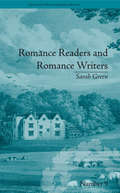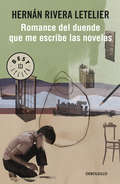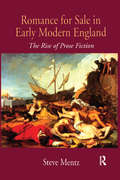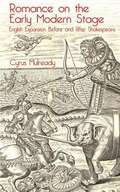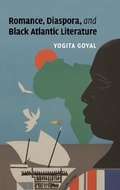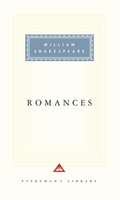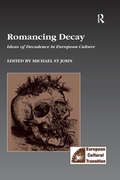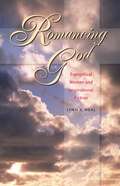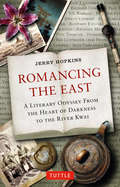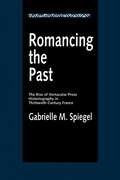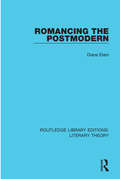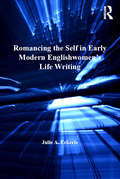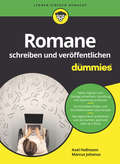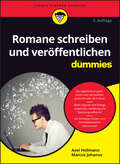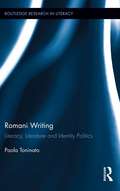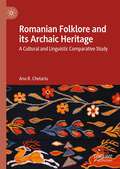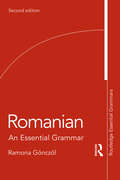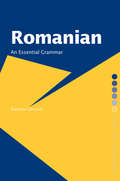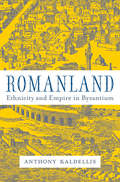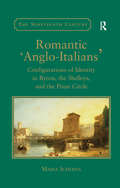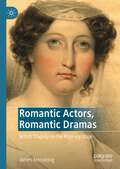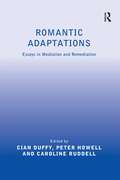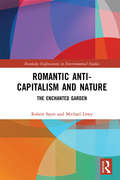- Table View
- List View
Romance Readers and Romance Writers: by Sarah Green (Chawton House Library: Women's Novels #9)
by Christopher GouldingThis edition of Romance Readers and Romance Writers (1810) is the first modern scholarly publication of what is arguably Green's most famous novel. As with many of her other works, Green adopts numerous sophisticated methods to parody her contemporaries.
Romance and History
by Jon WhitmanTo what extent can imaginative events be situated in time and history? From the medieval to the early modern period, this question is intriguingly explored in the expansive literary genre of romance. This collective study, edited by Jon Whitman, is the first systematic investigation of that formative process during more than four hundred years. While concentrating on changing configurations of romance itself, the volume examines a number of important related reference points, from epic to chronicle to critical theory. Recalling but qualifying conventional approaches to the three 'matters' of Rome, Britain, and France, the far-reaching inquiry engages major works in a variety of idioms, including Latin, French, English, German, Italian, and Spanish. With contributions from a range of internationally distinguished scholars, this unique volume offers a carefully coordinated framework for enriching not only the reading of romance, but also the understanding of changing attitudes toward the temporal process at large.
Romance and the Erotics of Property: Mass-Market Fiction for Women
by Jan CohnRomance and the Erotics of Property examines contemporary popular romance from a number of different points of view, probing for codes and subtexts that sometimes exploit and sometimes contradict its surface tale of romantic attraction, frustration, longing, and fulfillment. Cohn argues that a full understanding of the contemporary romance requires an investigation of its literary and historical sources and analogues. Three principal sources are examined in the context of women's history in bourgeois society. Pride and Prejudice, Jane Erye, and Gone With the Wind demonstrate the development of romance fiction's themes, yet in all three the central love story is complicated by issues of property, the sign of male power. Jan Cohn further considers the development of the genre n the fictions of Harriet Lewis and May Agnes Fleming, prolific and popular American romance writers of the late nineteenth century who developed the role of the villain, thereby bringing into focus the sexual and economic struggles faced by the heroine.
Romance del duende que me escribe las novelas
by Hernán Rivera LetelierCombinando trazos de su biografía con la historia de esta amistad maravillosa, Hernán Rivera Letelier presenta en esta novela una narración mágica y enternecedora, que ilumina, además, sobre los afectos y la capacidad creadora del artista. Es mejor callar si lo que vas a decir no es más bello que el silencio, fue lo primero que le oí a mi duende en la primera vez que se me apareció. Así comienza esta sorprendente novela de Hernán Rivera Letelier. Un niño solitario y dado a soñar despierto que encuentra en un duende a su mejor amigo. Mientras su familia padece las travesuras del pequeño ser, él disfruta de los juegos, la compañía y los consejos del geniecillo. De pronto, en la casa comenzaron a desaparecer algunos objetos; desaparecían de la noche a la mañana; en particular, pequeños utensilios de uso cotidiano. Cuando las botellas de agua y las de leche comenzaron a amanecer vacías, mi madre ya no tuvo ninguna duda al respecto. Y es que, según las viejas campesinas de su tierra, esas eran señales inequívocas de que un duende se había instalado en el hogar.
Romance for Sale in Early Modern England: The Rise of Prose Fiction
by Steve MentzThe major claim made by this study is that early modern English prose fiction self-consciously invented a new form of literary culture in which professional writers created books to be printed and sold to anonymous readers. It further claims that this period's narrative innovations emerged not solely from changes in early modern culture like print and the book market, but also from the rediscovery of a forgotten late classical text from North Africa, Heliodorus's Aethiopian History. In making these claims, Steve Mentz provides a comprehensive historicist and formalist account of prose romance, the most important genre of Elizabethan fiction. He explores how authors and publishers of prose fiction in late sixteenth-century England produced books that combined traditional narrative forms with a dynamic new understanding of the relationship between text and audience. Though prose fiction would not dominate English literary culture until the eighteenth century, Mentz demonstrates that the form began to invent itself as a distinct literary kind in England nearly two centuries earlier. Examining the divergent but interlocking careers of Robert Greene, Sir Philip Sidney, Thomas Lodge, and Thomas Nashe, Mentz traces how through differing commitments to print culture and their respective engagements with Heliodoran romance, these authors helped make the genre of prose fiction culturally and economically viable in England. Mentz explores how the advent of print and the book market changed literary discourse, influencing new conceptions of what he calls 'middlebrow' narrative and new habits of reading and writing. This study draws together three important strains of current scholarly inquiry: the history of the book and print culture, the study of popular fiction, and the re-examination of genre and influence. It also connects early modern fiction with longer histories of prose fiction and the rise of the modern novel.
Romance on the Early Modern Stage
by Cyrus MulreadyWhat is dramatic romance? Scholars have long turned to Shakespeare's biography to answer this question, marking his 'late plays' as the beginning and end of the dramatic romance. This book identifies an earlier history for this genre, revealing how stage romances imaginatively expanded audience interest in England's emerging global economy.
Romance, Diaspora, and Black Atlantic Literature
by Yogita GoyalRomance, Diaspora, and Black Atlantic Literature offers a rich, interdisciplinary treatment of modern black literature and cultural history, showing how debates over Africa in the works of major black writers generated productive models for imagining political agency. Yogita Goyal analyzes the tensions between romance and realism in the literature of the African diaspora, examining a remarkably diverse group of twentieth-century authors, including W. E. B. Du Bois, Chinua Achebe, Richard Wright, Ama Ata Aidoo and Caryl Phillips. Shifting the center of black diaspora studies by considering Africa as constitutive of black modernity rather than its forgotten past, Goyal argues that it is through the figure of romance that the possibility of diaspora is imagined across time and space. Drawing on literature, political history and postcolonial theory, this significant addition to the cross-cultural study of literatures will be of interest to scholars of African American studies, African studies and American literary studies.
Romances
by William ShakespeareFour plays by Shakespeare in one book--Pericles, Cymbeline, The Winter's Tale and The Tempest.
Romancing Decay: Ideas of Decadence in European Culture (Studies in European Cultural Transition #3)
by Michael St JohnThis collection of fifteen essays looks at the theme of decadence and its recurring manifestations in European literature and literary criticism from medieval times to the present day. Various definitions of the term are explored, including the notion of decadence as physical decay. Some of the essays draw parallels between modernist and postmodernist notions of decadence. Similarities are detected between fin de siècle decadence at the end of the nineteenth century (which reaches its apotheosis in the character of Eugene Wrayburn in Our Mutual Friend) and depictions of decadence in our own age as we enter the new millennium.
Romancing God
by Lynn S. NealIn the world of the evangelical romance novel, sex and desire are mitigated by an omnipresent third party--the divine. Thus romance is not just an encounter between lovers, but a triangle of affection: man, woman, and God. Although this literature is often disparaged by scholars and pastors alike, inspirational fiction plays a unique and important role in the religious lives of many evangelical women. In an engaging study of why women read evangelical romance novels, Lynn S. Neal interviews writers and readers of the genre and finds a complex religious piety among ordinary people.In evangelical love stories, the success of the hero and heroine's romance rests upon their religious choices. These fictional religious choices, readers report, often inspire real spiritual change in their own lives. Amidst the demands of daily life or during a challenge to one's faith, these books offer a respite from problems and a time for fun, but they also provide a means to cultivate piety and to appreciate the unconditional power of God's love. The reading of inspirational fiction emerges from and reinforces an evangelical lifestyle, Neal argues, but women's interpretations of the stories demonstrate the constant negotiations that characterize evangelical living. Neal's study of religion in practice highlights evangelicalism's aesthetic sensibility and helps to alter conventional understandings--both secular and religious--of this prominent subculture.
Romancing the East
by Jerry HopkinsFrom the time of Marco Polo's trek across the Central Asian desert to the empire of the mighty Kahn, no other place on earth, not the languid South Pacific or even deepest, darkest Africa has so challenged and enchanted the Western imagination as have the fabled lands of the East!However soaked in blood its history and no matter how unsettling its social conditions and poverty, Asia has never lost its irresistible attraction or mystic. Asia has long been an inspiration for Western novelists, so much so that more than 5000 novels have been set in Asia in the English language alone. Storied names like Rudyard Kipling, Joseph Conrad, Pearl S. Buck, George Orwell, Graham Greene, E.M. Forster and many more have used their experiences in Asia as a vibrant backdrop for some of the world's most famous works of literature.In Romancing the East, best-selling author Jerry Hopkins combines his research and his own experiences as a longtime expatriate with an intimate knowledge of Asia in offering us a unique perspective on the impact of Eastern culture in Western literature.
Romancing the Past: The Rise of Vernacular Prose Historiography in Thirteenth-Century France (The New Historicism: Studies in Cultural Poetics #23)
by Gabrielle M. SpiegelIn a poststructuralist study of thirteenth-century French historical texts, Gabrielle Spiegel investigates the reasons for the rise of French vernacular prose historiography at this particular time. She argues that the vernacular prose histories that have until now been regarded as royalist were actually products of the aristocracy, reflecting its anxiety as it faced social and economic change and political threats from the monarchy.
Romancing the Postmodern
by Diane ElamBy exposing the theory of romance to the romance of theory, Diane Elam explores literature’s most uncertain, least easily definable and most tenacious genre, assessing its implications for both feminism and the understanding of history. Arguing for a parallel between postmodernism’s divided relation to modernism and romance’s difficult stance towards realism, Romancing the Postmodern, first published in 1992, not only highlights how postmodernism questions our assumptions about historical time, it also reintroduces the figure of woman to the theory of both history and literature.
Romancing the Self in Early Modern Englishwomen's Life Writing (Women and Gender in the Early Modern World)
by Julie A. EckerleJuxtaposing life writing and romance, this study offers the first book-length exploration of the dynamic and complex relationship between the two genres. In so doing, it operates at the intersection of several recent trends: interest in women's contributions to autobiography; greater awareness of the diversity and flexibility of auto/biographical forms in the early modern period; and the use of manuscripts and other material evidence to trace literacy practices. Through analysis of a wide variety of life writings by early modern Englishwomen-including Elizabeth Delaval, Dorothy Calthorpe, Ann Fanshawe, and Anne Halkett-Julie A. Eckerle demonstrates that these women were not only familiar with the controversial romance genre but also deeply influenced by it. Romance, she argues, with its unending tales of unsatisfying love, spoke to something in women's experience; offered a model by which they could recount their own disappointments in a world where arranged marriage and often loveless matches ruled the day; and exerted a powerful, pervasive pressure on their textual self-formations. Romancing the Self in Early Modern Englishwomen's Life Writing documents a vibrant secular form of auto/biographical writing that coexisted alongside numerous spiritual forms, providing a much more nuanced and complete understanding of sixteenth- and seventeenth-century women's reading and writing literacies.
Romane schreiben und veröffentlichen für Dummies (Für Dummies)
by Axel Hollmann Marcus JohanusHaben Sie auch schon einmal mit dem Gedanken gespielt, Ihren eigenen Roman zu schreiben? Dieses Buch begleitet Sie auf Ihrem Weg als Schriftsteller. Axel Hollmann und Marcus Johanus helfen Ihnen, faszinierende Buchideen zu entwickeln, interessante Figuren zu erfinden, fesselnde Dialoge zu schreiben und spannende Handlungsbögen aufzubauen. Außerdem finden Sie in diesem Buch das wichtigste Handwerkszeug, das Sie als Romanautor beherrschen sollten und Möglichkeiten, Ihr Buch als gedrucktes Buch oder E-Book, im Selfpublishing oder bei einem Verlag zu publizieren und zu vermarkten.
Romane schreiben und veröffentlichen für Dummies (Für Dummies)
by Axel Hollmann Marcus JohanusRomane schreiben und veröffentlichen Finden Sie den Roman in sich Haben Sie auch schon einmal mit dem Gedanken gespielt, Ihren eigenen Roman zu schreiben? Dieses Buch begleitet Sie auf Ihrem Weg als Schriftsteller. Axel Hollmann und Marcus Johanus helfen Ihnen, faszinierende Buchideen zu entwickeln, interessante Figuren zu erfinden, fesselnde Dialoge zu schreiben und spannende Handlungsbögen aufzubauen. Außerdem finden Sie in diesem Buch das wichtigste Handwerkszeug, das Sie als Romanautor beherrschen sollten, und Möglichkeiten, Ihren Roman als gedrucktes Buch oder E-Book, im Selfpublishing oder bei einem Verlag zu publizieren und zu vermarkten. Sie erfahren Was es über Drei-Akte-Struktur, Heldenreise und Erzählperspektive zu wissen gibt Wie Sie Ihr Werk überarbeiten Was Sie von Agenten und Verlagen erwarten können Wie Sie sich in den sozialen Medien präsentieren
Romani Writing: Literacy, Literature and Identity Politics (Routledge Research in Literacy)
by Paola ToninatoThe Roma (commonly known as "Gypsies") have largely been depicted in writings and in popular culture as an illiterate group. However, as Romani Writing shows, the Roma have a deep understanding of literacy and its implications, and use writing for a range of different purposes. While some Romani writers adopt an "oral" use of the written medium, which aims at opposing and deconstructing anti-Gypsy stereotypes, other Romani authors use writing for purposes of identity-building. Writing is for Romani activists and intellectuals a key factor in establishing a shared identity and introducing a common language that transcends linguistic and geographical boundaries between different Romani groups. Romani authors, acting in-between different cultures and communication systems, regard writing as an act of cultural mediation through which they are able to rewrite Gypsy images and negotiate their identity while retaining their ethnic specificity. Indeed, Romani Writing demonstrates how Romani authors have started to create self-images in which the Roma are no longer portrayed as "objects", but become "subjects" of written representation.
Romanian Folklore and its Archaic Heritage: A cultural and Linguistic Comparative Study
by Ana R. ChelariuThis book presents rich information on Romanian mythology and folklore, previously under-explored in Western scholarship, placing the source material within its historical context and drawing comparisons with European and Indo-European culture and mythological tradition. The author presents a detailed comparative study and argues that Romanian mythical motifs have roots in Indo-European heritage, by analyzing and comparing mythical motifs from the archaic cultures, Greek, Latin, Celtic, Sanskrit, and Persian, with written material and folkloric data that reflects the Indo-European culture. The book begins by outlining the history of the Getae-Dacians, beginning with Herodotus' description of their customs and beliefs in the supreme god Zamolxis, then moves to the Roman wars and the Romanization process, before turning to recent debates in linguistics and genetics regarding the provenance of a shared language, religion, and culture in Europe. The author then analyzes myth creation, its relation to rites, and its functions in society, before examining specific examples of motifs and themes from Romanian folk tales and songs. This book will be of interest to students and scholars of folklore studies, comparative mythology, linguistic anthropology, and European culture.
Romanian: An Essential Grammar (Routledge Essential Grammars)
by Ramona GönczölNow in its second edition, Romanian: An Essential Grammar is a concise, user-friendly guide to modern Romanian. It takes the student through the essentials of the language, explaining each concept clearly and providing many examples of contemporary Romanian usage. This fully revised second edition contains: • a chapter of each of the most common grammatical areas with Romanian and English examples • extensive examples of the more difficult areas of the grammar • a section with exercises to consolidate the learning and the answer key • a list of useful verbs • an appendix listing useful websites for further information • a glossary of grammatical terms used in the book • a useful bibliographical list. Suitable for both classroom use and independent study, this book is ideal for beginner to intermediate students.
Romanian: An Essential Grammar (Routledge Essential Grammars)
by Ramona GönczölThis book is suitable for independent and classroom learners, ideal for the beginner to intermediate student, and takes the reader through the essentials of the language explaining each concept clearly and providing many examples of contemporary Romanian usage. The book contains: a chapter on each of the most common grammatical areas with Romanian and English examples extensive examples of the more difficult areas of the grammar an appendix listing relevant websites for further information on the Romanian language.
Romanland: Ethnicity and Empire in Byzantium
by Anthony KaldellisWas there ever such a thing as Byzantium? Certainly no emperor ever called himself Byzantine. While the identities of eastern minorities were clear, that of the ruling majority remains obscured behind a name made up by later generations. Anthony Kaldellis says it is time for the Romanness of these so-called Byzantines to be taken seriously.
Romantic 'Anglo-Italians': Configurations of Identity in Byron, the Shelleys, and the Pisan Circle (The Nineteenth Century Series)
by Maria SchoinaFocusing on key members of the Pisan Circle, Byron, the Shelleys, and Leigh Hunt, Maria Schoina explores configurations of identity and the acculturating practices of British expatriates in post-Napoleonic Italy. The problems involved in British Romanticism's relations to its European 'others' are her point of departure, as she argues that the emergence and mission of what Mary Shelley termed the 'Anglo-Italian' is inextricably linked to the social, political, economic, and cultural conditions of the age: the forging of the British identity in the midst of an expanding empire, the rise of the English middle class and the establishment of a competitive print culture, and the envisioning, by a group of male and female Romantic liberal intellectuals, of social and political reform. Schoina's emphasis on the political implications of the British Romantics' hyphenated self-representation results in fresh readings of the Pisan Circle's Italianate writings that move them away from interpretations focused on a purely aesthetic or poetic attachment to Italy to uncover their complex ideological underpinnings. Recognizing that Mary Shelley was instrumental in conceptualizing the Romantics' discourse of acculturation expands our understanding of this phenomenon, as does Schoina's convincing case for the importance of gender as a major determinant of Mary Shelley's construction of Anglo-Italianness.
Romantic Actors, Romantic Dramas: British Tragedy on the Regency Stage
by James ArmstrongThis book reinterprets British dramas of the early-nineteenth century through the lens of the star actors for whom they were written. Unlike most playwrights of previous generations, the writers of British Romantic dramas generally did not work in the theatre themselves. However, they closely followed the careers of star performers. Even when they did not directly know actors, they had what media theorists have dubbed "para-social interactions" with those stars, interacting with them through the mediation of mass communication, whether as audience members, newspaper and memoir readers, or consumers of prints, porcelain miniatures, and other manifestations of "fan" culture. This study takes an in-depth look at four pairs of performers and playwrights: Sarah Siddons and Joanna Baillie, Julia Glover and Samuel Taylor Coleridge, Edmund Kean and Lord Byron, and Eliza O'Neill and Percy Bysshe Shelley. These charismatic performers, knowingly or not, helped to guide the development of a character-based theatre—from the emotion-dominated plays made popular by Baillie to the pinnacle of Romantic drama under Shelley. They shepherded in a new style of writing that had verbal sophistication and engaged meaningfully with the moral issues of the day. They helped to create not just new modes of acting, but new ways of writing that could make use of their extraordinary talents.
Romantic Adaptations: Essays in Mediation and Remediation
by Peter Howell Cian DuffyHow did romanticism define its relationship with its sources? How has romanticism since been understood and misunderstood across a range of cultural activities? These are among the questions taken up in this reexamination of the place of adaptation within romanticism. Renegotiating the cultural topography of the period and the place of romanticism in subsequent cultural history, the volume focuses on the adaptation of source material by romantic writers and the adaptation in subsequent periods of the tropes and ideologies associated with romanticism. In place of a hierarchical distinction between source and text, between ’romanticism’ and its contexts, the collection identifies distinct but overlapping and mutually constitutive genres such as the Gothic and romance. Whether their essays deal with early nineteenth-century periodical reviews, affordable editions of Pride and Prejudice aimed at the late nineteenth-century mass audience, or the ongoing cultural presence of romanticism in late twentieth- and early twenty-first-century debates about embryology and stem cell research, the contributors remain cognizant of the tension between the processes of adaptation and the apparent ideology of romantic originality.
Romantic Anti-capitalism and Nature: The Enchanted Garden (Routledge Explorations in Environmental Studies)
by Michael Löwy Robert SayreRomantic Anti-capitalism and Nature examines the deep connections between the romantic rebellion against modernity and ecological concern with modern threats to nature. The chapters deal with expressions of romantic culture from a wide variety of different areas: travel writing, painting, utopian vision, cultural studies, political philosophy, and activist socio-political writing. The authors discuss a highly diverse group of figures - William Bartram, Thomas Cole, William Morris, Walter Benjamin, Raymond Williams, and Naomi Klein - from the late eighteenth to the early twenty-first century. They are rooted individually in English, American, and German cultures, but share a common perspective: the romantic protest against modern bourgeois civilisation and its destruction of the natural environment. Although a rich ecocritical literature has developed since the 1990s, particularly in the United States and Britain, that addresses many aspects of ecology and its intersection with romanticism, they almost exclusively focus on literature, and define romanticism as a limited literary period of the late eighteenth and early nineteenth centuries. This study is one of the first to suggest a much broader view of the romantic relation to ecological discourse and representation, covering a range of cultural creations and viewing romanticism as a cultural critique, or protest against capitalist-industrialist modernity in the name of past, pre-modern, or pre-capitalist values. This book will be of great interest to students and scholars of ecology, romanticism, and the history of capitalism.
